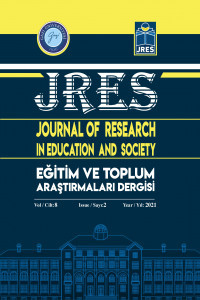SÜRTÜNMELİ EĞİK DÜZLEMDE HAREKETİN DİNAMİĞİNE İLİŞKİN ÖĞRENCİ GÖRÜŞLERİ
Bu
araştırma lise ikinci sınıf öğrencilerinin sürtünmeli eğik düzlemde hareketin
dinamiğine ilişkin görüşlerini belirlemek amacıyla yapılmıştır. Bu amaçla
veri toplamak için iki bölümden oluşan açık uçlu Sürtünmeli Eğik Düzlemde
Hareket Testi (SEDHT) geliştirilmiştir. Birinci bölümde, sürtünmeli eğik düzlem
ve üzerinde bulunan bir cisminden oluşan sistemde yapılan bazı
değişikliklerin cismin hareketini nasıl etkileyebileceği konusunda görüşleri
alınmıştır. İkinci bölümdeyse, sistemin serbest cisim diyagramını çizmeleri
istenilmiş, cismin hareketine hangi kuvvetlerin neden olduğu veya engel
olduğu sorulmuştur. Araştırma, Ankara merkezde iki liseden toplam 108
öğrencinin katılımıyla gerçekleşmiştir. Araştırmanın sonucunda; öğrencilerin
büyük çoğunluğunun, sürtünmeli eğik düzlemin üzerindeki bir cismin; konumu ve
kütlesi gibi olaya etkisi olmayan değişkenlerin, cismin hareketine bir etkisi
olduğunu düşündükleri; öğrencilerin çizdiği serbest cisim diyagramlarının
büyük çoğunluğunda, hareketin temelinde yatan kuvvetlerin hiç gösterilmediği
veya hatalı gösterildiği, ortamda var olmayan kuvvetlerin varmış gibi
çizilerek sisteme dışarıdan kuvvetler eklendiği, çizimlerde gösterilen
kuvvetlerden, harekete neden olan veya engel olan kuvvetleri olması
gerekenden farklı düşündükleri belirlenmiştir.
Anahtar Kelimeler:
Sürtünmeli eğik düzlemde hareket, Kavram yanilgilari, Fizik eğitimi
STUDENT OPINIONS ABOUT DYNAMICS OF MOTION ON FRICTION INCLINED PLANE
This study was carried out to determine the opinions of
second-grade high school students about dynamics of motion on a friction
inclined plane. For this study, an open-ended Friction Inclined Plane Motion
Test (SEDHT), consisting of two sections, was developed as the data
collection tool. In the first section, students’ opinions about how some
changes made on the system of a body on a friction inclined plane can affect
the motion of the body are taken. In the second section, the students are
asked to draw a free-body diagram of the system and expected to state the
forces that cause the motion of the body or inhibit it. A total of 108
students, studying in two high schools in Ankara, participated in the study.
According to the study results, most of the students think that the location
and the mass of a body on a friction inclined plane affect the motion of the
body. In addition, the results indicated that in most of the free-body
diagrams drawn by the students, the forces causing the motion were not shown
at all or were shown incorrectly, and some forces that never exist were added
to the system. Finally, the study found out that the students had
misconceptions about the forces causing or inhibiting the motion shown in the
diagrams.
___
- Clement, J. (1998). Expert Novice Similarities and Instruction Using Analogies, International Journal of Science Education, v20 n10 p1271.
- Dumas-Carré, A., & Goffard, M. (1997). Rénover les activités de résolution de problémes en physique. Paris: Armand Colin/Masson.
- Erduran Avcı, D., Kara İ. & Karaca, D. (2012). Fen Bilgisi Öğretmen Adaylarının İş Konusundaki Kavram Yanılgıları. Pamukkale Üniversitesi Eğitim Fakültesi Dergisi, 31 (Ocak 2012/I), 27-39.
- Eryılmaz, A. & Tatlı, A. (2000). ODTÜ Öğrencilerinin Mekanik Konusundaki Kavram Yanılgıları. Hacettepe Üniversitesi Eğitim Fakültesi Dergisi 18, 93-98.
- Hast, M., & Howe, C. (2012). Understanding the beliefs informing children’s commonsense theo¬ries of motion: the role of everyday object variables in dynamic event predictions. Research in Science ve Technological Education, 30(1), 3–15.
- Hast, M., & Howe, C. (2013). The Development of Children’s Understanding of Speed Change: A Contributing Factor Towards Commonsense Theories of Motion. Journal of Science Education and Technology, 22(3), 337–350. doi:10.1007/s10956-012-9397-5
- Heller, P., Keith, R., & S.Anderson. (1992). Teaching problem solving through cooperative grouping. Part 1.Group versus individual problem solving. Am. J. Phys., 60, 627–636.
- Henderson, T. (2006). The Physics Classroom Tutorial: Force and Its Representation http://www.glenbrook.k12.il.us/gbssci/phys/CLass/newtlaws/u2l2c.html
- Hestenes D., Wells M. & Swackhamer G. (1992). Force Concept Inventory. The Physics Teacher, 30 (3), 141-151.
- Heuvelen, A. V. (1991a). Overview, Case Study Physics. Am. J. Phys., 59, 898–907.
- Heuvelen, A. V. (1991b). Learning to think like a physicist: A review of research-based instructionalstrategies. Am. J. Phys., 59, 891–897.
- Jones, A. Z. (2007). Free-Body Diagrams: An Introduction, http://physics.about.com/od/to
- olsofthetrade/qt/freebodydiagram.htm
- Kuru İ., & Güneş B. (2005). Lise 2. Sınıf Öğrencilerinin Kuvvet Konusundaki Kavram Yanılgıları, Gazi Eğitim Fakültesi Dergisi, 25 (2), 1-17.
- Serway R. A. & Beichner, R. J. (2002). Fen ve Mühendislik İçin Fizik. Üçüncü Baskıdan Çeviri. Ankara: Palme Yayıncılık.
- URL-1 (2016) < http://hyperphysics.phy-astr.gsu.edu/hbase/hframe.html ,>
- URL-2 (2016).
- URL-3 (2016).
- Yavuz, A., Baykal, B., & Temiz, B. K. (2014). Yarış Probleminde Kütlenin Anlamlandırılması. K. Ü. Kastamonu Eğitim Dergisi, 23(2), 601-618.
- Yavuz, A. & Özdemir, G. (2009). Öğretim Elemanlarının Atwood Aleti Problemi Çözüm Stratejilerinin Prakseolojik Analizi. Uludağ Üniversitesi Eğitim Fakültesi Dergisi 22(2), 357-377.
- Yayın Aralığı: Yılda 2 Sayı
- Başlangıç: 2014
- Yayıncı: Gazi Üniversitesi
